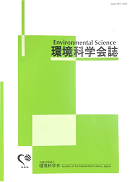
- Issue 2 Pages 33-
- Issue 1 Pages 1-
- |<
- <
- 1
- >
- >|
-
Masahiro ISHIKAWA, Keisuke MATSUHASHI, Yuko KANAMORI2024 Volume 37 Issue 2 Pages 33-42
Published: March 31, 2024
Released on J-STAGE: March 31, 2024
JOURNAL FREE ACCESSThe purpose of this study is to estimate household sector energy consumption by fuel type at the municipal level based on a regression model created using microdata from the household CO2 statistics survey. The regression model to be created uses electricity, gas, i.e., the sum of city gas and LP gas, and kerosene energy consumption per household as the objective variables, and household-level variables such as household size and building type, and city-level variables such as population density and heating degree days as explanatory variables. This regression model is created for each of the 10 regional divisions. The regression models for gas and kerosene use the concept of a two-part model. The estimated energy consumption per household by fuel type obtained from the regression model is approximately 90% of the published household CO2 statistics. It was inferred that the variables used in the projections were the main reason for the underestimation. Further research will be conducted to develop reliable statistical indicators that will contribute to policy formation for regional decarbonization.
View full abstractDownload PDF (664K) -
Atsuko KURIMOTO2024 Volume 37 Issue 2 Pages 43-52
Published: March 31, 2024
Released on J-STAGE: March 31, 2024
JOURNAL FREE ACCESS“Regulatory objectivity” has been discussed as a novel aspect of scientific objectivity in the biomedical field. It emphasizes the co-production of evidence, resulting in clinical objectivity. Using the Japanese bovine spongiform encephalopathy (BSE) inspection system from October 2001 as a case study, this study examines the implementation of administrative inspection in public health policy from the perspective of regulatory objectivity. The results reveal that, in addition to scientific reliability, regulatory objectivity is incorporated into administrative inspection, considering the feasibility of implementation. In previous studies, regulatory objectivity has been primarily associated with clinical medicine. Nevertheless, this case study, which focuses on administrative inspection, can be perceived as being constructed with the assumption of impacting a broader range of stakeholders, including the government, consumers, and producers. Moreover, the available resources and technologies during the establishment of the inspection system were utilized and institutionalized in a path-dependent manner, resulting in technological lock-in. Therefore, implementing new technologies in policies necessitates not only a significant improvement in detection sensitivity but also the development of a diagnostic market, which may weaken the incentive for restructuring, especially as infectious diseases are eradicated.
View full abstractDownload PDF (430K) -
Teruaki KINOSHITA, Tomoko ODA, Shou KURITA, Takako YAMAZAKI, Akiko INO ...2024 Volume 37 Issue 2 Pages 53-63
Published: March 31, 2024
Released on J-STAGE: March 31, 2024
JOURNAL FREE ACCESSA screening analysis database of 168 pesticides in drinking water for gas chromatography-mass spectrometry (GC/MS) analysis was developed using an Agilent GC/MS system. The qualitative and quantitative accuracy was evaluated using standard solutions and river water samples. One month after the database was developed, the screening analysis was conducted again for each pesticide using 0.05 mg/L standard solution. As a result, 162 of the 168 pesticides registered in the database were identified. On the other hand, there were some pesticides that should be carefully identified. In order to compare the test results of the screening analysis and standard analysis methods, both methods were applied to river water samples at five sites in the Tamagawa River basin. The results showed that all pesticides detected by both methods were the same, even though they were conducted by different inspectors. The concentration ratio between the screening analysis and standard analysis ranged from 0.63 to 0.98, indicating that the quantitative error of the screening analysis method was within one-half to two times of the standard analysis. In conclusion the screening analysis method developed in this study is useful in the testing of pesticides in drinking water samples.
View full abstractDownload PDF (656K)
- |<
- <
- 1
- >
- >|